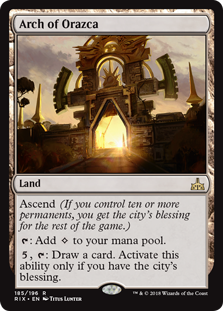It’s been said before, and we’ll continue to repeat it until the stars fade and the music stops: not every card is designed for every audience. Whether it’s the format, casting cost, or the theme of the set itself, there’s copious variety to the types of cards and card effects out there and who its intended player base is. Card mechanics, unsurprisingly, are no exception. Some mechanics are unequivocally designed for quick, brutal skirmish games, whereas others have a markedly more broad-based appeal to them. Although less common in main sets, supplemental sets even contain mechanics primarily suited for multiplayer. And while you can run nearly any card mechanic in any format it’s eligible for, that doesn’t always mean it’s all that advantageous.
A classic example of this is Hellbent. Taking into account the fact that it’s not universally beloved in general, you are far more likely to see this used in drafts or single player games. This makes sense – the tradeoff for powering up card effects at the expense of an empty hand is much more palatable when you only have one front to concern yourself with. In multiplayer, it’s almost always a non-starter. Very few EDH players ever want a completely empty hand. It telegraphs way too much information to all of your enemies and is a very clear indicator that you’re vulnerable both in the moment and in surprise response when your turn comes around again. In multiplayer, an empty hand is simply too much of an invitation for punishment.
Other mechanics scale in the opposite direction. Whereas some mechanics thrive by the limitations of players and a rapidly-changing board state, others absolutely flourish when they have the time they often aren’t afforded. One of the best examples of that in recent memory is Ixalan’s Ascend.
Ascend is a simple boost mechanic, which states that if at any point in the game you control ten or more permanents, you gain the “city’s blessing” effect. Not unlike emblems, once you have the city’s blessing it’s active for the remainder of the game and there is no way to get rid of it. Once achieved, any cards you have with Ascend provide more potent effects and abilities.
One can see what the mechanic encourages, tying itself into the set’s storyline of numerous factions racing to the central city. In a 1 v 1 setting, this makes for an electric contest to see if you can reach that point of ten simultaneous permanents on the battlefield before the game is over such that you can take advantage of the effects. Yet in multiplayer, getting to ten permanents isn’t a matter of if but a matter of when. In Commander settings, reaching a combination of ten lands, creatures, and other permanents is nearly as easy as, well, counting to ten. The average EDH deck can accomplish this around turn 6 or so – which in this format is still considered opening rounds. The mechanical tension around reaching it here is entirely obviated, but you’re still able to take advantage of the benefits its provides.
So, with that in mind, this week’s card pick is all about celebrating this mechanic and the upside advantages it brings with it.
Today we have: Arch of Orazca

Name: Arch of Orazca
Edition: Rivals of Ixalan
Rarity: Rare
Focus: Card Draw
Highlights: One avenue most Magic players new to the lengthier and more complicated multiplayer scene struggle with is the entire prospect of needing to prepare for as many contingencies as you reasonably can. Whereas in a standard 1 v 1 you have the luxury of focusing on optimizing your deck to play the way you want. At best you sideboard a handful of cards to address what your opponent’s deck may be up to and how to stop it.
In Commander, those contingency cards are typically folded into the decks ahead of time. However, because of the multitude of variables that come with each and every Commander game, you can’t guarantee what you’re going to face from session to session. Ergo, the more cards you can shove into the deck to deal with situational and contingency-based issues – without sacrificing the viability of your deck to function – the better off you are.
Enter Arch of Orazca.
Arch of Orazca is an incredibly simple and straightforward card for Commander and its usefulness is nearly self-evident. At its absolute worst, it is a non-basic land that produces colorless mana. Once you reach the necessary 10 permanents threshold – ironically easier to accomplish than something like Threshold – you gain access to its activated ability. It states that for five mana and tapping, you can draw a card. That’s it. No deep-seated nuance. Just…draw a card.
Some may balk at the prospect of effectively paying six mana to draw a single card, but the purpose is all about trying to squeeze advantage in wherever you can. Arch of Orazca isn’t intended to be your primary card drawing mechanism. Rather, it’s a nice lever to pull in the middle to later stages of the game when you have extra mana to spare and want to draw an extra card. Plus, it can’t be overstated that it is card draw on a land, making it slightly difficult to get rid of. Moreover, the card’s colorless nature makes it viable for a wide spectrum of Commander decks.
Is this a powerhouse card? No. But sometimes getting that one extra card in a timely manner can mean the difference between survival and defeat. It does the one thing you can never have too much of in a Commander game: provide options. And that’s certainly a blessing of its own.
Keep an eye out for us to be regularly featuring other more accessible-but-worth-it Commander cards going forward. In the meantime, we’ll keep the light on for you.
![]()
You can discuss this article over on our social media!
